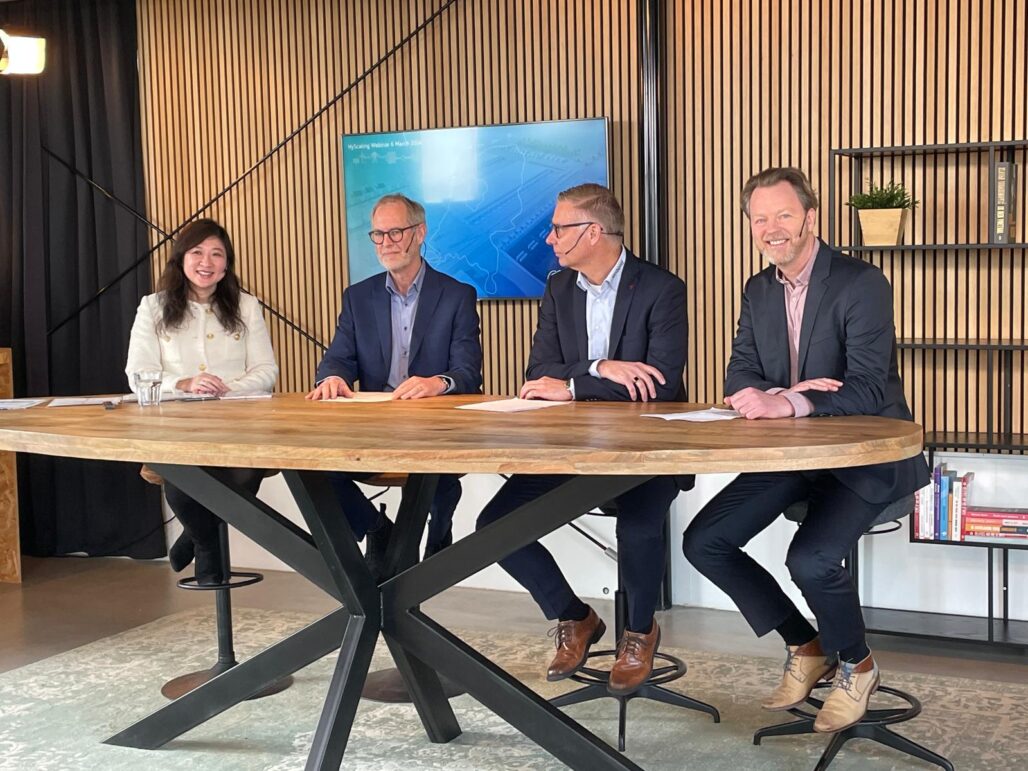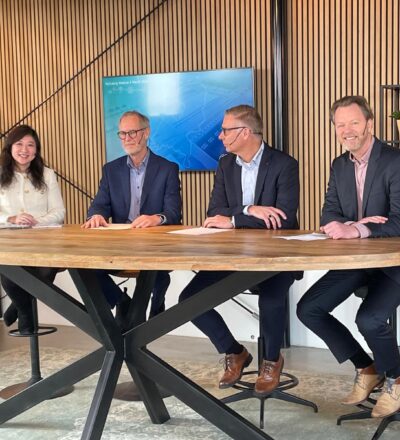What is the vision for PEM at multi-gigawatt scale? When scaling up electrolysis for green hydrogen, should we build larger modules or duplicate modules? Additionally, considering market trends, how will the costs of PEM technology evolve compared to other technologies? To answer these burning questions on technological developments in PEM and Alkaline Water Eletrolysis for green hydrogen production, we brought together 6 experts from the HyScaling consortium.
On the 6th of March 2024 we took a deep dive into the technological hydrogen developments during our first HyScaling webinar. Several experts shared their insights integral to the HyScaling project, a 3-year initiative concluding this summer. In this project we developed innovations for scaling up hydrogen production, taking the entire hydrogen chain in consideration.

PEM versus Alkaline
Specialists Ton Hurkmans (CTO at IHI Ionbond Group), Mark Breed (New Business Development Manager at Teijin) and Paul Peters (Process and project engineer MTSA) gathered to discuss the strategic importance of PEM electrolysis innovations for green hydrogen. Meanwhile Thijs de Groot (Associate Professor at TU/e), Marco Wonink (AWE Lead Scientist at TNO) and Ahmad Harbiye (Sr. Research Scientist at VECO) explored the necessities and gaps in scaling up the Alkaline Water Electrolysis technologies.
Green hydrogen Q&A
During our webinar, we received an overwhelming amount of questions in the chat. Our experts answered most of them on the spot. Questions that were still outstanding, are answered in this article. We are happy to share them in the Q&A below.
Watch the webinar on technological developments for green hydrogen production
The webinar is in Dutch, and is subtitled in English.
Q&A
Q: Has the consortium critically examined the future of PEM at a multi-gigawatt scale regarding the availability of anode catalysts? What is your vision on this?
A: Paul Peters: “For the multi-gigawatt scale, the alkaline technology is the best choice when the input (electricity) and the output (for example feedstock) must be is stable. But a few PEM electrolysers can be added to the total for the flexible part. So a mix will give the best solution. Also new PEM electrolysers do need less Iridium. So I think there will be enough possibilities for PEM, especially when it is used for the right purpose; flexibility and compactness.”
Q: What are the requirements for the feedwater of the electrolyzer? And is there a difference between alkaline and PEM?
A: Thijs de Groot: Electrolyzers require a pure water feed, but the extent to which purification needs to be carried out differs per technology and can even differ within a technology. Mostly the purity requirements are expressed in a conductivity. PEM electrolyzers are known to be especially vulnerable to impurities and therefore need a very pure water input with a very low conductivity (can be as low as <0.1 microS/cm). This also applies to some of the advanced alkaline electrolyzers. In contrast, more traditional alkaline electrolyzers can also work with higher impurity levels and conductivity (up to 10 microS/cm).
Q: Is PEM more flexible regarding start-stop compared to alkaline?
A: Ton Hurkmans: “In my understanding, yes it is.”
Q: Given recent advancements and market trends, how do you foresee the cost development of PEM technology compared to other technologies such as alkaline electrolysis and SOEC in the next decade? Could you also elaborate on the key factors influencing this?
A: Mark Breed: “One of the key factors in the levelized cost of green hydrogen (LOCH) is the price of electricity. Depending on the ‘use case’ this can vary significantly. This also implies that the system efficiency is a key factor in the costs. PEM has one of the highest efficiencies of all water electrolyses concepts and has potential to further increase the efficiency. Besides this, the PEM concept, has a good capacity flexibility performance. Therefore the PEM concept can be integrated better in combination with intermittent electricity supply of renewable energy and dynamic electricity prices, reducing the LOCH.”
Q: Do PFAS residues end up in H2 and wastewater with PFAS-containing membrane?
A: Paul Peters: “When there are residues, it will come in the pure water system, not in the H2 system. The pure water system is recycled and filtered constantly. That’s why it will never come in the waste water. When there is PFAS in the water (never heard that it is measured) it will be accumulated in the resin filter. There are some reports describing fluorine in the waste water, but the amounts are very small. The conductivity of the pure water is constantly measured and is not really increasing. I have only experiences with one kind of fluor containing membrane. I don’t know if there are differences, but I am expecting that these differences will be very small.”
Q For upscaling hydrogen production with PEM electrolysers, should we develop bigger modules or focus of duplication of modules?
A: Mark Breed: “PEM seems to have a modular character. Bigger, meaning larger cells and number of cells in a stack doesn’t give advantages so far and only add a lot of stack design complexity. Most OEMs are standardizing sizes and are preparing for fully automized mass produced modular stacks. Once the (circular) value chain is in place and automized, the cost of modular PEM stacks can be significantly reduced by economy of scale. The modular concept gives further capacity and expansion flexibility in large scale electrolyser plant operations.”
Also watch HyScaling Webinar Part 2
During the 2nd webinar we will further explore the results of the HyScaling project. This time with a special focus on the green hydrogen applicability studies and use cases. We will discuss potential business cases, key enablers and diverse applications of green hydrogen in our economy and Dutch society.
Acknowledgement
This project is co-funded with subsidy from the Topsector Energy by the Ministry of Economic Affairs and Climate Policy.
